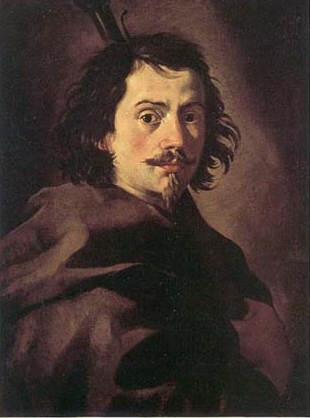
Francesco Borromini, byname of Francesco Castelli, was an Italian architect born in the modern Swiss canton of Ticino who, with his contemporaries Gian Lorenzo Bernini and Pietro da Cortona, was a leading figure in the emergence of Roman Baroque architecture.

The Church of the Gesù is the mother church of the Society of Jesus (Jesuits), a Catholic religious order. Officially named Chiesa del Santissimo Nome di Gesù all'Argentina, its facade is "the first truly baroque façade", introducing the baroque style into architecture. The church served as a model for innumerable Jesuit churches all over the world, especially in the Americas. Its paintings in the nave, crossing, and side chapels became models for Jesuit churches throughout Italy and Europe, as well as those of other orders. The Church of the Gesù is located in the Piazza del Gesù in Rome.

Santa Maria delle Grazie is a church and Dominican convent in Milan, northern Italy, and a UNESCO World Heritage Site. The convent contains the mural of The Last Supper by Leonardo da Vinci, which is in the refectory.
Santa Maria delle Grazie may refer to:

The Parish Basilica of Santa Maria del Popolo is a titular church and a minor basilica in Rome run by the Augustinian order. It stands on the north side of Piazza del Popolo, one of the most famous squares in the city. The church is hemmed in between the Pincian Hill and Porta del Popolo, one of the gates in the Aurelian Wall as well as the starting point of Via Flaminia, the most important route from the north. Its location made the basilica the first church for the majority of travellers entering the city. The church contains works by several famous artists, such as Raphael, Gian Lorenzo Bernini, Caravaggio, Alessandro Algardi, Pinturicchio, Andrea Bregno, Guillaume de Marcillat and Donato Bramante.
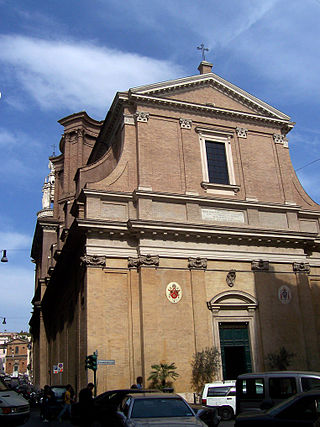
Sant'Andrea delle Fratte is a 17th-century basilica church in Rome, Italy, dedicated to St. Andrew. The Cardinal Priest of the Titulus S. Andreae Apostoli de Hortis is Ennio Antonelli.
Cortemaggiore is an Italian comune located in the Province of Piacenza. Cortemaggiore is located in the northern Italy about 80 kilometres (50 mi) from Milan and 120 kilometres (75 mi) from Bologna, in the Pianura Padana. The municipality borders with Fiorenzuola d'Arda, Villanova sull'Arda, Besenzone, San Pietro in Cerro, Caorso, Pontenure and Cadeo.
Zuglio is a comune (municipality), former bishopric and Latin Catholic titular see in the Province of Udine in the northeastern Italian autonomous region Friuli-Venezia Giulia, located about 110 kilometres (68 mi) northwest of Trieste and about 45 kilometres (28 mi) northwest of Udine in the Val Bût.
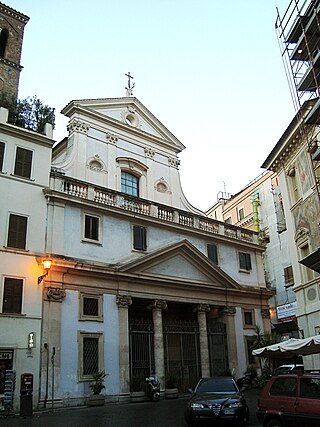
Sant'Eustachio[santeuˈstaːkjo] is a Roman Catholic titular church and minor basilica in Rome, named for the martyr Saint Eustace. It is located on Via di Sant'Eustachio in the rione Sant'Eustachio, a block west of the Pantheon and via della Rotonda, and a block east of Sant'Ivo alla Sapienza and the Via della Dogana Vecchia.

Santi Luca e Martina is a church in Rome, Italy, situated between the Roman Forum and the Forum of Caesar and close to the Arch of Septimus Severus.

Giuseppe Bartolomeo Chiari, also known simply as Giuseppe Chiari, was an Italian painter of the late-Baroque period, active mostly in Rome.
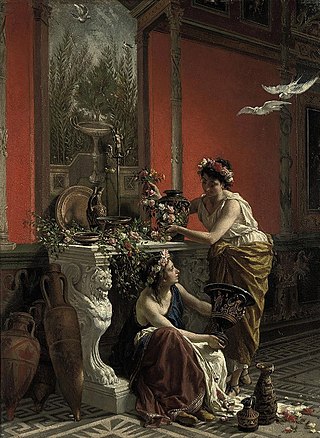
Cesare Mariani was an Italian painter and architect of the late-19th century, active in Rome and Ascoli Piceno.

The Ancient Royal and Eminent Basilica Collegiate of Our Lady of the Alms better known as Basilica della Colleggiata is a church in Catania, Sicily, southern Italy. Finished in 1794, it is an example of Sicilian Baroque.
Arcangelo Guglielmelli was an Italian architect and painter, active in his native Naples, Italy, in a late-Baroque style. He was involved in the building and reconstruction of churches, many of which had been damaged by the earthquakes of 1688 and 1694.

The church of Santa Maria delle Grazie in Brescia is located on at the west end of Via Elia Capriolo, where it intersects with the Via delle Grazie. Built in the 16th century and remodeled in the 17th century, it still retains much of its artwork by major regional artists, including one of its three canvases by Moretto. The other two are now held at the Pinacoteca Tosio Martinengo. The interior is richly decorated in Baroque fashion. Adjacent to the church is the Sanctuary of Santa Maria delle Grazie, a neo-gothic work.

Porta Cavalleggeri was one of the gates of the Leonine Wall in Rome (Italy).

The Complesso di San Firenze is a 17th-century Baroque-style building, consisting of a church, palace, and former oratory, located on the southeast corner of the saucer-shaped piazza of San Firenze, located in the quartiere of Santa Croce in central Florence, region of Tuscany, Italy. The buildings were commissioned by the Oratorians of Saint Philip Neri.

Mario Zenari is an Italian prelate of the Catholic Church who has been a cardinal since 2016. He has served his entire ecclesiastical career in the diplomatic service of the Holy See, holding senior positions beginning in 1999. He has been Apostolic Nuncio to Syria since 30 December 2008. He was nuncio to Sri Lanka from 2004 to 2008.
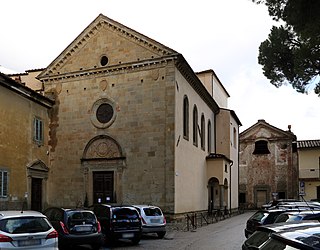
Santa Maria delle Grazie, also known as Madonna del Letto, is a Renaissance-style, Roman Catholic church located near the city center in Pistoia, region of Tuscany, Italy.

Aurelio is the 13th quartiere of Rome (Italy), identified by the initials Q. XIII. It belongs to the Municipio XIII and Municipio XIV.


















